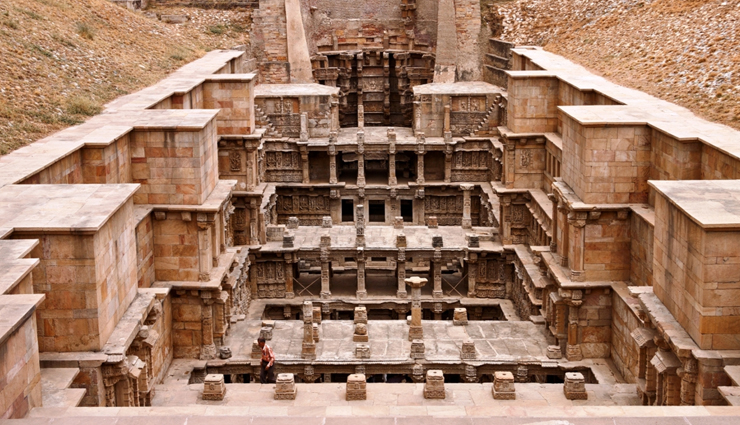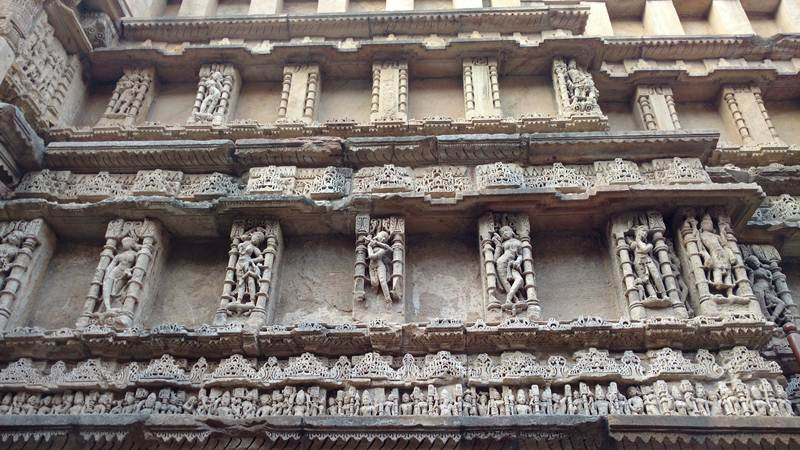This Stepwell Of Gujarat Tells Tales Of Women And Life
By: Priyanka Maheshwari Tue, 28 July 2020 8:41:39

Stepwells (known as vavs) are a familiar feature in the landscape of Gujarat. They differ from ordinary wells in that they have steps leading down from the ground to the water-level. Water is not drawn by rope but by descending the steps of the multi-storied structure. But most of all, unlike ordinary wells, they are a world unto themselves and a revelation for a visitor.
Water and Women
Water, being a basic need, has often been venerated for its life-giving properties. The act of providing water is associated with earning merit. More so, in a land with scanty rainfall and an arid landscape, building a well was seen as an act deserving great merit. In this context, water also came to bear a close association with fertility as it was responsible for the growth of crops and cattle.
Women too have a deep association with water for somehow, the duty of collecting water has over the centuries been relegated to them. Even today, women and girls often spend hours each day, walking to and collecting water.
Stepwells were the spaces where the world of women and water converged. It was a space that women could visit freely, not just to collect water but also for socialising and recreation. Secluded below the surface and away from the male gaze, women could gather and be themselves. Friends could meet and chat. Girls could sing and dance. Inhibitions could melt away.
Perhaps in the modern age, serviced with piped water and water pumps, it is difficult to understand their significance, but during medieval times, these wells were a great blessing for people, particularly for women. “Stepwells are a window into the lives of ordinary women. One can imagine the kind of lives they led, the deities they worshipped, the beliefs they held by observing the architecture of these vavs,” explains Shilpa Chedda, visiting faculty at Mumbai University and curator at Heras Centre of St Xavier’s College, Mumbai.
It comes as no surprise therefore that more than a fifth of these wells were commissioned by women. From queens to wives of rich merchants, courtesans to servant girls – women had a large role to play in the construction of stepwells in Gujarat.

The Queen’s Stepwell
One of the most spectacular of these wells is the Rani ni vav or the Queen’s Well in Patan, which has been granted the status of an UNESCO World Heritage site for its sheer beauty and grandeur. It is said to have been built by Queen Udaimati, wife of Raja Bhima Dev in the 11th century AD and is the most ornately decorated well in the world.
Profusely carved and sculpted, images of 200 apsaras or celestial nymphs abound on its walls. As one descends its steps, one can see Anjana adorning her eyes with kohl and Nupura, slipping on an anklet. The Darpana-Sundari admires her reflection in the mirror as the Karna-Sundari puts on her earrings. The Kapura-sundari dries her long-flowing hair even as the Aalas-Kanya lazily stretches her curvaceous body. Each of these sculptures has been carved to perfection, revealing a high level of aesthetic and artistic skill of the craftsman.
Images of kirtimukhas are found on the steps to ward off the evil eye along with the kshetrapala or the guardian deity who protects the well. Latikas (creepers) add a decorative element while the geometric shapes of the patolagive it a distinctly local feel. Shaded pavilions offer a weary traveller a place to rest, away from the scorching rays of the sun.
Gods and goddesses, demi gods and deities, water nymphs and celestial musicians – they all make a striking appearance as one descends the steps. In the centre, Vishnu reclines in his Shesha-naag position after having sustained and provided for the world.
While there are many step wells in Gujarat, the Rani-ni-Vav is noteworthy for its intricate sculpture-work and deserves to be included in any travel itinerary to the state.





